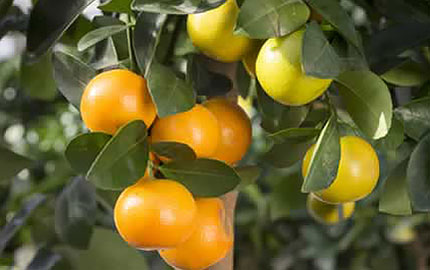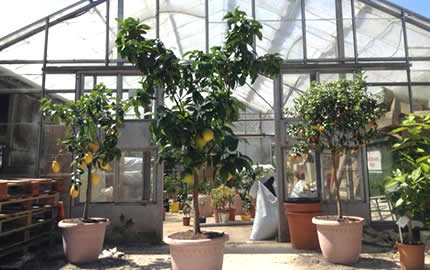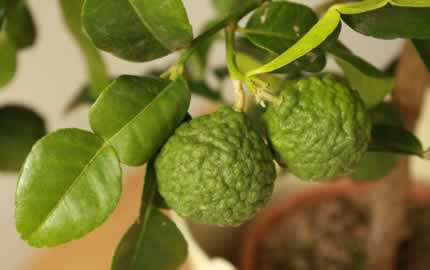Caring for your citrus trees in the autumn
Watch our TOP 10 tips for looking after citrus and learn how to get the most from these rewarding plants.
As the weather and day length changes, so does the care that your citrus trees need. Because sometimes people can be caught out by this, we've put together our top 5 tips to remember for this season.
Our TOP 5 Autumn Citrus Plant Care Tips
1. Watering
As the days get shorter and the temperature drops, water evaporates more slowly. But also because your citrus tree is no longer putting on new growth, the amount of water your tree will need will decrease quite dramatically .
As always water heavily from the top and let the excess water drain away. Don't let your citrus tree stand in water and don't water again until the top of the soil is bone dry to the touch.
In our nursery in Sussex, we have gone from daily watering in summer, to watering two or three times a week at the moment and we will ease off further as the days get shorter and cooler.
2. Position
Consider moving your trees inside. That means the very lightest place you can find indoors.
Citrus trees fall into 3 main categories for hardiness:-
Non-hardy Calamondins, Sweet Oranges, Kumquats, Tahiti Limes, Grapefruits and Mandarins should be kept above 5C and it's best to move them inside before the night time temperature drops much below this. Choose the sunniest place in the house away from draughts and radiators.
Hardier Lemon trees, chinottos and kaffir limes will be fine in temperatures right down to zero and will even tolerate -1C or 2C for short periods. Depending upon where you are in the country, that means they probably don’t need to come in just yet but keep an eye on the forecast and remember it’s not the leaves you need to worry about but the rootball – this must not freeze!
You can wrap the pot with hessian or fleece to extend the season outdoors and/or bring it close to the wall of your house to give your tree a bit of extra protection. When you think it is going to be too cold overnight it's best to move your tree to a new position for the coming months rather than try and move it in and out and every day.
Hardy Yuzus and Finger Limes can withstand temperatures down to -5C. It's still best to keep these in a pot as they will suffer if they become too waterlogged but these hardy varieties are grown on Poncirus trifoliate stock and should withstand all that a British winter can throw at them.
3. Winter Feed
Citrus benefit from a balanced Summer and Winter Citrus Feed.
The Summer feed has more Nitrogen for leaf growth and the winter feed has proportionately more Phosphorous and Potassium to help develop fruits. Now is a good time to swop over from Summer to Winter Feed and don’t forget to do it every other watering to keep your tree at it’s best.
You should be able to buy citrus feed from a good garden centre or of course you can buy the citrus feed we use for £7.50 and have it delivered free of charge. Buy winter feed
4. Watch for Leaf Drop
Citrus trees are not deciduous. One or two leaves is not too much of a concern but more than this and it’s a sign that your tree is unhappy. This is almost always to do with too little or too much water – not sure which? And it can be tricky – Give us a call on 01825 721162 and we’ll do our best to advise you. Other things that can cause leaf drop are sudden or dramatic changes in temperature, under floor heating or being too near to a radiator or being in too draughty a position - but again if you're not sure - do get in touch.
5. Treat early for Pests
Outdoors birds and other insects plus the cooler night time temperatures will keep most pests at bay which is another good reason to keep plants outside as long as you can. Indoors over winter, the warm conditions can become breeding grounds for pests so it's a good idea to give your plants a really good check over before bringing them in for the winter.
Scale, mealy bug, red spider mite, aphids and caterpillars all do like citrus trees but the trick is to catch them early. Round brown circles, white sticky fluff, webbing, holes in the leaves or stickiness are all signs of pest attack and should be treated as soon as possible. A solution made up of diatomacheous earth and washing up liquid is our go to solution if the infestation hasn't got too advanced. Follow our plant pest guide and spray on to the leaves morning or evening a few times a week until it's cleared.
Alternatively our friends at www.ladybirdplantcare.co.uk sell a whole host of effective natural predator controls.
.Not sure what you've got? send us a picture by email or via our Facebook page or give us a call and we'll be more than happy to help you identify any problems.
Before moving plants indoors in the autumn always have a good check for pests. Round brown circles, white sticky fluff, webbing, holes in the leaves or stickiness are all signs of pest attack and should be treated as soon as possible.
And finally.... it's time to start thinking about the fruits of your labours!
Although citrus don't always follow a strict fruiting season in the UK, they do usually fruit in the winter months. Lemon meyers, limes, grapefruits, kumquats and clementines will naturally drop when they are ripe, but lemon4seasons, calamondins and chinottos will need to be picked off the tree when they are fully coloured. If this is your first year don't worry it can take a long time for fruits to ripen so be prepared to be a little patient at the moment.
Surprisingly, autumns shorter days and the difference between day time and night time temperatures are actually the trigger for most citrus and particularly lemons and oranges to ripen - so counter-intuitively leaving your trees outside as long as possible can speed up the ripening process but it will all be worth the wait it in the end!
For more information about pruning, repotting and year round care check out our other plant care guides.




